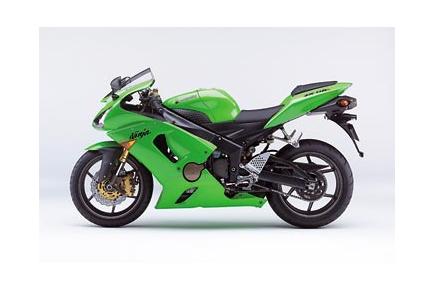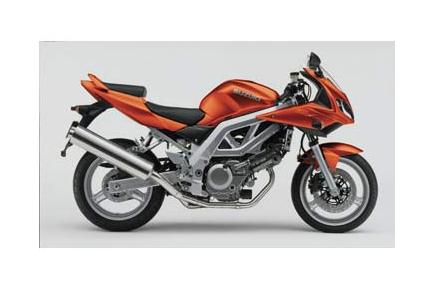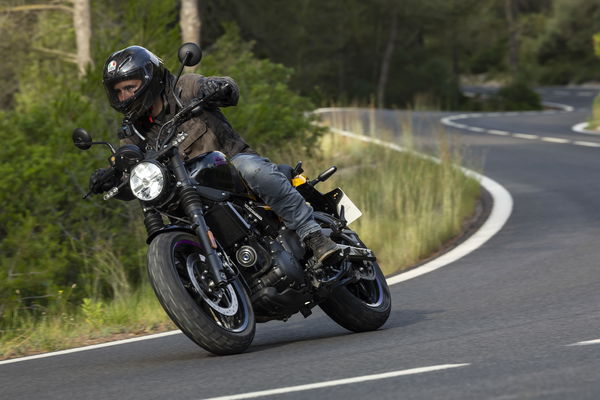Ninja ZX-6RR (2004 - ) review
In standard form it’s a slower and more expensive version of the R, with the race kit it gets more interesting and with a load of investment in the engine could become an utter tool. A 600 for serious racers with deep pockets only

Before any new bike can line up on a world Supersport grid, homologation rules stipulate at least 1,000 road legal units of the same basic bike must be made available to the public – Supersport is after all a roadbike-based championship. So it’s no surprise to see Kawasaki making just 1,000 of these ZX-6RRs for public consumption.
Homologation specials are nothing new but Kawasaki’s tack with the RR is somewhat different. See, with most bikes like this you’ll find them wearing more exclusive chassis components and more radical geometry than their standard roadgoing companions but this isn’t the case with the RR. It has the same frame, forks, wheels, suspension, clocks, exhaust and bodywork as the standard R version. Up close the two bikes look identical and it’s only the discreet ‘RR’ logo on the sidepanels that finally gives the game away.
The only differences you’ll find on the RR are the adjustable swingarm pivot and the smaller regulation friendly 599cc motor inside the frame with its close-ratio gearbox and slipper clutch.
So you pay a grand more and you get a slower bike, albeit one with a tricker motor. But there’s still no substitute for cubes and riding the two back to back the R murders its RR cousin across the rev range, so much so I was at least one and a half seconds a lap slower on the RR no matter what I tried.
So why should anyone buy an RR? The simple answer is that they shouldn’t. No point. Sorry. As they come the R’s the better road bike and the better track bike of the pair.
The only reason to buy an RR is to go supersport racing because at 636ccs the R is nothing less than a very unsubtle bit of cheating that’ll see you slung out of any 600cc race you care to take a crack at.
And for racing the RR suddenly begins to make sense because throw in the factory race kit (once you’ve shelled out the extra grand for it that is) and suddenly you’ve got a pretty sorted piece of racing tackle on your hands.
I say ‘pretty sorted’ because the race kit is far from comprehensive. As it stands you get a full selection of gaskets, air filters, valve springs, sprockets and camshafts, a programmable ECU (adjusts fuel mixture, ignition timing and rev limiter) with relevant connectors, a race tacho, fork spacers and springs, and a smaller generator with matching cover. Not bad value for a grand, but you’ll still want spare wheels, a steering damper and a race system at the bare minimum before taking to the track.
Properly set up with said exhaust Kawasaki claim you’ll see some 120bhp and compression up to 14.5: 1 (the R runs 12.8:1). From here the sky’s the limit depending on what level you’re competing at, how much you can bend the rules and how deep your pockets are.
In short, the ZX-6RR is a very sound building block for a serious racebike. The sublime handling and braking of the roadbike are there from the beginning and what you do with them is your business. Just don’t buy a standard RR to impress your mates at a trackday – you’ll get your ass whupped.
Before any new bike can line up on a world Supersport grid, homologation rules stipulate at least 1,000 road legal units of the same basic bike must be made available to the public – Supersport is after all a roadbike-based championship. So it’s no surprise to see Kawasaki making just 1,000 of these ZX-6RRs for public consumption.
Homologation specials are nothing new but Kawasaki’s tack with the RR is somewhat different. See, with most bikes like this you’ll find them wearing more exclusive chassis components and more radical geometry than their standard roadgoing companions but this isn’t the case with the RR. It has the same frame, forks, wheels, suspension, clocks, exhaust and bodywork as the standard R version. Up close the two bikes look identical and it’s only the discreet ‘RR’ logo on the sidepanels that finally gives the game away.
The only differences you’ll find on the RR are the adjustable swingarm pivot and the smaller regulation friendly 599cc motor inside the frame with its close-ratio gearbox and slipper clutch.
So you pay a grand more and you get a slower bike, albeit one with a tricker motor. But there’s still no substitute for cubes and riding the two back to back the R murders its RR cousin across the rev range, so much so I was at least one and a half seconds a lap slower on the RR no matter what I tried.
So why should anyone buy an RR? The simple answer is that they shouldn’t. No point. Sorry. As they come the R’s the better road bike and the better track bike of the pair.
The only reason to buy an RR is to go supersport racing because at 636ccs the R is nothing less than a very unsubtle bit of cheating that’ll see you slung out of any 600cc race you care to take a crack at.
And for racing the RR suddenly begins to make sense because throw in the factory race kit (once you’ve shelled out the extra grand for it that is) and suddenly you’ve got a pretty sorted piece of racing tackle on your hands.
I say ‘pretty sorted’ because the race kit is far from comprehensive. As it stands you get a full selection of gaskets, air filters, valve springs, sprockets and camshafts, a programmable ECU (adjusts fuel mixture, ignition timing and rev limiter) with relevant connectors, a race tacho, fork spacers and springs, and a smaller generator with matching cover. Not bad value for a grand, but you’ll still want spare wheels, a steering damper and a race system at the bare minimum before taking to the track.
Properly set up with said exhaust Kawasaki claim you’ll see some 120bhp and compression up to 14.5: 1 (the R runs 12.8:1). From here the sky’s the limit depending on what level you’re competing at, how much you can bend the rules and how deep your pockets are.
In short, the ZX-6RR is a very sound building block for a serious racebike. The sublime handling and braking of the roadbike are there from the beginning and what you do with them is your business. Just don’t buy a standard RR to impress your mates at a trackday – you’ll get your ass whupped.
| Length (mm) | 2025 |
| Width (mm) | 720 |
| Height (mm) | 1110 |
| Seats | 0 |
| Seat Height (mm) | 825 |
| Suspension Front | 41mm inverted cartridge fork |
| Suspension Rear | Bottom-Link Uni-Trak with gas-charged shock |
| Adjustability Front | Rebound and compression damping and spring preload; top-out springs |
| Adjustability Rear | Rebound and compression damping and spring preload; top-out springs |
| Tyres Front | 120/65ZR17M/C |
| Tyres Rear | 180/55ZR17M/C |
| Brakes Front | Dual semi-floating 280mm discs with dual radial mount, opposed 4-piston, 4 pad |
| Brakes Rear | Single 220mm disc with single-bore pin slide |
| Tank Capacity (litres) | 18 |
| Wheelbase (mm) | 1400 |
| Ground Clearance (mm) | 130 |
| Rake (degrees) | 24.5 |
| Trail (mm) | 95 |
| Chassis | Perimeter, pressed aluminium |
| Cubic Capacity (cc) | 599 |
| Valves | 16 |
| Bore (mm) | 67 |
| Stroke (mm) | 42.5 |
| Compression Ratio | 13.5 |
| Ignition | Digital |
| Valves Per Cylinder | 4 |
| Cooling | Liquid cooled |
| Fuel Delivery | Twin injection |
| Stroke Type | Four Stroke |
| Drive | Chain |
| Top Speed |











